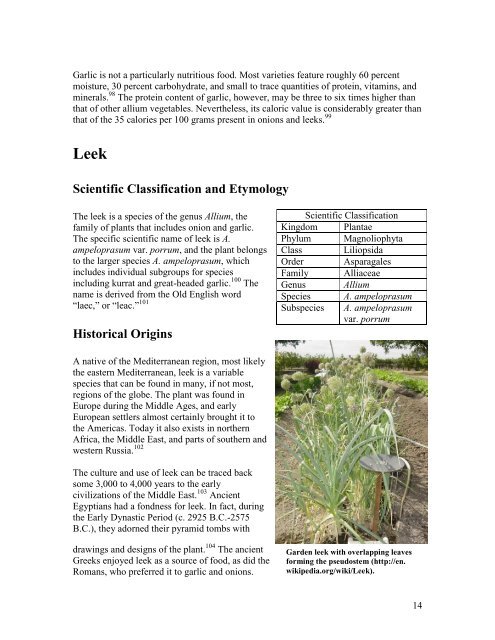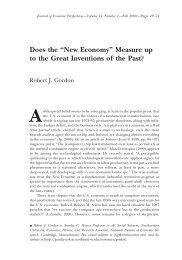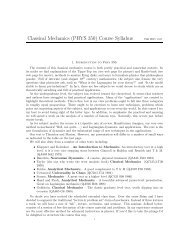Leek Scientific Classification and Etymology - Academics - Hamilton ...
Leek Scientific Classification and Etymology - Academics - Hamilton ...
Leek Scientific Classification and Etymology - Academics - Hamilton ...
Create successful ePaper yourself
Turn your PDF publications into a flip-book with our unique Google optimized e-Paper software.
Garlic is not a particularly nutritious food. Most varieties feature roughly 60 percent<br />
moisture, 30 percent carbohydrate, <strong>and</strong> small to trace quantities of protein, vitamins, <strong>and</strong><br />
minerals. 98 The protein content of garlic, however, may be three to six times higher than<br />
that of other allium vegetables. Nevertheless, its caloric value is considerably greater than<br />
that of the 35 calories per 100 grams present in onions <strong>and</strong> leeks. 99<br />
<strong>Leek</strong><br />
<strong>Scientific</strong> <strong>Classification</strong> <strong>and</strong> <strong>Etymology</strong><br />
The leek is a species of the genus Allium, the<br />
family of plants that includes onion <strong>and</strong> garlic.<br />
The specific scientific name of leek is A.<br />
ampeloprasum var. porrum, <strong>and</strong> the plant belongs<br />
to the larger species A. ampeloprasum, which<br />
includes individual subgroups for species<br />
including kurrat <strong>and</strong> great-headed garlic. 100 The<br />
name is derived from the Old English word<br />
“laec,” or “leac.” 101<br />
Historical Origins<br />
A native of the Mediterranean region, most likely<br />
the eastern Mediterranean, leek is a variable<br />
species that can be found in many, if not most,<br />
regions of the globe. The plant was found in<br />
Europe during the Middle Ages, <strong>and</strong> early<br />
European settlers almost certainly brought it to<br />
the Americas. Today it also exists in northern<br />
Africa, the Middle East, <strong>and</strong> parts of southern <strong>and</strong><br />
western Russia. 102<br />
The culture <strong>and</strong> use of leek can be traced back<br />
some 3,000 to 4,000 years to the early<br />
civilizations of the Middle East. 103 Ancient<br />
Egyptians had a fondness for leek. In fact, during<br />
the Early Dynastic Period (c. 2925 B.C.-2575<br />
B.C.), they adorned their pyramid tombs with<br />
drawings <strong>and</strong> designs of the plant. 104 The ancient<br />
Greeks enjoyed leek as a source of food, as did the<br />
Romans, who preferred it to garlic <strong>and</strong> onions.<br />
<strong>Scientific</strong> <strong>Classification</strong><br />
Kingdom Plantae<br />
Phylum Magnoliophyta<br />
Class Liliopsida<br />
Order Asparagales<br />
Family Alliaceae<br />
Genus Allium<br />
Species A. ampeloprasum<br />
Subspecies A. ampeloprasum<br />
var. porrum<br />
Garden leek with overlapping leaves<br />
forming the pseudostem (http://en.<br />
wikipedia.org/wiki/<strong>Leek</strong>).<br />
14






